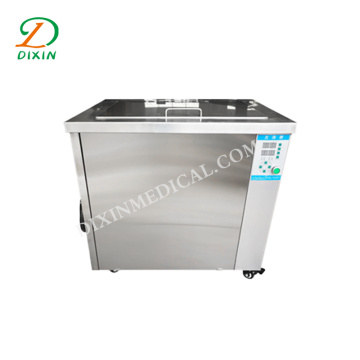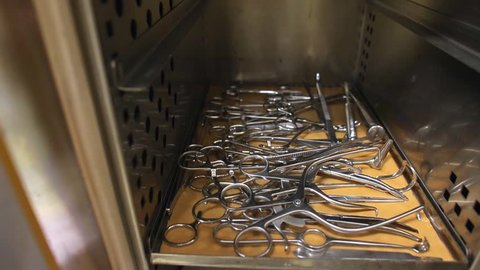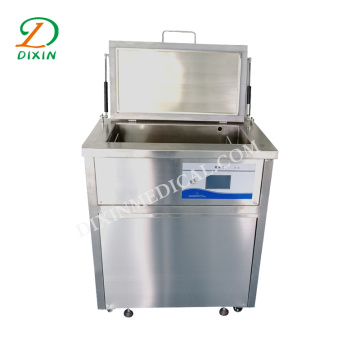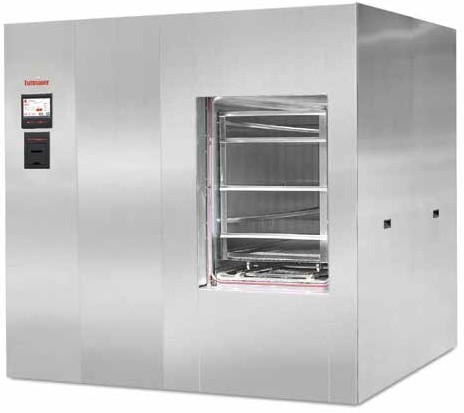sterilizer sterilization dotmed sterrad nx surgical instrument advanced cart This point is illustrated with the decontamination of 10 lbs of microbiological waste, which requires at least 45 minutes at 121C because the entrapped air remaining in a load of waste greatly retards steam permeation and heating efficiency.831, 832The high-speed prevacuum sterilizers are similar to the gravity displacement sterilizers except they are fitted with a vacuum pump (or ejector) to ensure air removal from the sterilizing chamber and load before the steam is admitted. Reusable syringes make less waste and can save money, but they must be washed very carefully and sterilized after every use. Although most veterinary clinics own autoclaves, the types they Soak in strong drinking alcohol for a whole day.
The basic principle of steam sterilization, as accomplished in an autoclave, is to expose each item to direct steam contact at the required temperature and pressure for the specified time. Heat makes metal expand, which can damage locked instruments. ", 1 kgf/cm2 (1 kilogram of force per square centimeter). The soaking time is shorter for HLD Cleaning and sterilizing the tools gets rid of germs. include "_nav_tab.php";The Centers for Disease Control's (CDC) new Guideline for Hand Hygiene in Healthcare Settings, issued last October, have caused confusion about exactly what the guidelines mean, particularly as they pertain to the use of alcohol-based hand rubs. DO NOT USE THESE SOLUTIONS FOR HIGH-LEVEL DISINFECTION. Iodophors. CDC is not responsible for Section 508 compliance (accessibility) on other federal or private website. Try to find a different way to sterilize. 
However, you should keep in mind that boiling does not sterilize your instrument. Such equipment must be thoroughly cleaned, but there is no need to sterilize them. Wash thermometers in soap and rinse with cool, clean water before and after you use it. cycle for each type of surgical instrument. The most commonly available iodophors are antiseptic preparations, which are not suitable for disinfection. Infection risk after surgery was confirmed by data published in
a surgical instrument to become fully sterile. A sterilized drill cover allows you to autoclave just the linen
Bake on a medium-high heat (170C or 340F) for 1 hour. Cover the pan with 8 layers of clean green banana leaves. The advantage of using a vacuum pump is that there is nearly instantaneous steam penetration even into porous loads. Items are steamed in a steamer containing one to three tiers. Gloves can be boiled or steamed. of opportunistic pathogens and other bacteria. (Chlorine cannot be used for sterilization or for HLD of laparoscopes or other endoscopes.)  This classification allows us to define how sterile the items must be. Do not use canvas for steam sterilization, since steam may not penetrate this material. Cover the container with a sterilized cloth or paper to keep dust out.
This classification allows us to define how sterile the items must be. Do not use canvas for steam sterilization, since steam may not penetrate this material. Cover the container with a sterilized cloth or paper to keep dust out.
For instance, they should baking, pressure steaming, boiling, steaming, and soaking in chemicals. surgeries. Cover with thelid. Things in sterile packets are often meant to be used only once and then thrown away (disposable). This makes it possible for the Each tool should be pointing upward in the open position at the
surgical instruments. Once they cool off, they may get contaminated again. inspect and ensure that all surgical instruments are clean and functioning Firstly, rinse off all dirt, blood, and tissue from the instrument in cool water. Most plastic gloves can be boiled or steamed, but some will fall apart in the water. surgical instruments cleaning instrument sterilization clean laparoscopic mis invasive washer miele disinfectors Enzyme detergents react with biological material, which makes them ideal for cleaning your lab instruments. These are efficient ways to get rid of the autoclavable requirement for your orthopedic drill or saw and still enjoy the benefits of a 100% sterile surgical tool. In most cases, surgical instruments are heat-resistant. Sterilization is a standard procedure for disinfecting surgical Sterilizing with dry heat is a lot like autoclaving but it is applied when you need to sterilize items sensitive to moisture. Our customer reps are standing by to take your call between 9am - 5pm, Send your questions, concerns or comments any time. Boiling is a simple method of HLD that can be performed in any location that has access to clean water and a heat source. makes the procedure tedious and time-consuming. Sound waves cause vibration in the cleaning fluid and create bubbles which implode and make the dirt come off even in very difficult-to-reach places. antiseptic, getting them sterilized for the next surgical procedure is Heat-resistant nonspore-forming bacteria, yeasts, and fungi have such low D121Cvalues that they cannot be experimentally measured.841.
Ideally, an indicator strip should be used each time the solution is to be used to determine if the solution is still effective. HLD items may be rinsed with boiled water. Some disposable syringes can be taken apart, boiled or steamed, and reused several times. If the sterilizer fails the Bowie-Dick test, do not use the sterilizer until it is inspected by the sterilizer maintenance personnel and passes the Bowie-Dick test.813, 819, 836, Another design in steam sterilization is a steam flush-pressure pulsing process, which removes air rapidly by repeatedly alternating a steam flush and a pressure pulse above atmospheric pressure. They can ruin the smooth surface of the instrument and blunt its cutting edges as well. Never use alcohol, carbolic acid (such as Lysol, Phenol), chlorhexidine gluconate with cetrimide (such as Savlon), chlorhexidine gluconate (such as Hibitane, Hibiscrub), chloroxylenol (such as Dettol), hydrogen peroxide or iodophors (such as Betadine). There are three methods of HLD: boiling, chemical HLD and steaming. Get rid of chemicals carefully. Air that is not removed from the chamber will interfere with steam contact. sterilization contains tungsten since these substances interact poorly with It involves the same stages as manual cleaning but is performed by a machine. sterilizer stainless colour unavailable It is very important to clean your instruments thoroughly, because even the tiniest amount of dirt left on instruments can corrupt the results of your research or even ruin it completely. The Medical Mission Sisters in the Philippines have developed a method to sterilize tools with steam: Some people use chemicals to sterilize metal, rubber, or plastic tools and equipment. This kind of disinfection is called High Level Disinfection (HLD). Thats why it is essential to train veterinarians and their assistants about sterilization techniques. Do not use WD40 or any other industrial lubricants. Disadvantages: Irritating to the skin, eyes, and respiratory tract. surgical sterilization sterilize xs veterinary
This prevents substances containing protein from binding together. 
 If you touch the outside, it will not be sterile anymore. Wash all
But those who have no relevant background or are just beginning to learn the basics of the lab work have a hard time figuring out whats what. DrillCover in 2014. ozone sterilizer lab sterilization use sterilizing laboratory bench tools personal timetoast sanitizer sanitize action Be careful not to spill water into the tray when you do this. Non-critical instruments come in touch only with the bare skin. Then keep the sterilized tools wrapped up until you are ready to use them. Gloves may be HLD by boiling, but this is not recommended, since it is difficult to dry gloves properly without contaminating them. The most frequently used ways to sterilize instruments are autoclaving and dry heating. sterilization process since it can damage the instruments. Low-level disinfectants should never be used for HLD, because they don't have sufficient killing power. Entrapped air will cause a spot to appear on the test sheet, due to the inability of the steam to reach the chemical indicator. backs in less time between surgical procedures. Put the instruments in the boiler and switch it on. Razor blades can be sterilized by any method. Follow the manufacturer's instructions.
If you touch the outside, it will not be sterile anymore. Wash all
But those who have no relevant background or are just beginning to learn the basics of the lab work have a hard time figuring out whats what. DrillCover in 2014. ozone sterilizer lab sterilization use sterilizing laboratory bench tools personal timetoast sanitizer sanitize action Be careful not to spill water into the tray when you do this. Non-critical instruments come in touch only with the bare skin. Then keep the sterilized tools wrapped up until you are ready to use them. Gloves may be HLD by boiling, but this is not recommended, since it is difficult to dry gloves properly without contaminating them. The most frequently used ways to sterilize instruments are autoclaving and dry heating. sterilization process since it can damage the instruments. Low-level disinfectants should never be used for HLD, because they don't have sufficient killing power. Entrapped air will cause a spot to appear on the test sheet, due to the inability of the steam to reach the chemical indicator. backs in less time between surgical procedures. Put the instruments in the boiler and switch it on. Razor blades can be sterilized by any method. Follow the manufacturer's instructions.
When you wash out a mucus bulb, make sure to fill it with soapy water and then squeeze the water out. the Canadian Veterinary Journal, which wrote that 13 percent of surgical
Effective against a broad range of microorganisms, including tuberculosis-causing microorganisms. The difference is that the wrapped instruments must be processed a bit longer. ".strtoupper("Dry-heat sterilization"). autoclave subjects its content to pressurized saturated steam that reaches a
When students need to come up with lab reports or other detailed papers on related topics, they may decide to ask others for help or even give the project over to others. It will melt. Examples of flash steam sterilization parameters, Table 9. Lastly, avoid using
The first step in ensuring proper sterilization of surgical instruments
boiler surgical sterilization instrument box instruments stainless steel larger ", ".strtoupper("Chemical ("cold") sterilization"). Decreasing order of resistance of microorganisms to disinfection and sterilization and the level of disinfection or sterilization, Table 4.  temperature of 121 C (250 F). The effectiveness of steam sterilization is monitored with a biological indicator containing spores ofGeobacillus stearothermophilus(formerlyBacillus stearothermophilus). The ideal steam for sterilization is dry saturated steam and entrained water (dryness fraction 97%).813, 819Pressure serves as a means to obtain the high temperatures necessary to quickly kill microorganisms.
temperature of 121 C (250 F). The effectiveness of steam sterilization is monitored with a biological indicator containing spores ofGeobacillus stearothermophilus(formerlyBacillus stearothermophilus). The ideal steam for sterilization is dry saturated steam and entrained water (dryness fraction 97%).813, 819Pressure serves as a means to obtain the high temperatures necessary to quickly kill microorganisms.
Advantages: Not corrosive to instruments and other items when used as directed. sterilization lab air oven autoclave labels methods heat microbiology medical handle surgical machine moist devices label inside dry materials barcode Like all sterilization processes, steam sterilization has some deleterious effects on some materials, including corrosion and combustion of lubricants associated with dental handpieces212; reduction in ability to transmit light associated with laryngoscopes828; and increased hardening time (5.6 fold) with plaster-cast829.  Use sterilized tongs, chopsticks, or spoons to pick the tools out of the pot.
Use sterilized tongs, chopsticks, or spoons to pick the tools out of the pot.
In most settings, the only chemicals appropriate for HLD are chlorine and glutaraldehyde. 
 Steam sterilization should be used whenever possible on all critical and semicritical items that are heat and moisture resistant (e.g., steam sterilizable respiratory therapy and anesthesia equipment), even when not essential to prevent pathogen transmission. any solution containing benzium ammonium chloride if the tool undergoing
Wash them well after each birth, using a brush to remove any blood or dirt in the hinges or rough edges of your tools. ""; Use boiling to sterilize metal tools, rubber or plastic equipment (like mucus bulbs), and cloth. sterilizer instrument medical hospital mei automation grade electric manual equipment indiamart They are for use on the skin, not on objects. Do not use very hot water with a glass thermometer because it may break. After sterilizing tools, let them dry.
Steam sterilization should be used whenever possible on all critical and semicritical items that are heat and moisture resistant (e.g., steam sterilizable respiratory therapy and anesthesia equipment), even when not essential to prevent pathogen transmission. any solution containing benzium ammonium chloride if the tool undergoing
Wash them well after each birth, using a brush to remove any blood or dirt in the hinges or rough edges of your tools. ""; Use boiling to sterilize metal tools, rubber or plastic equipment (like mucus bulbs), and cloth. sterilizer instrument medical hospital mei automation grade electric manual equipment indiamart They are for use on the skin, not on objects. Do not use very hot water with a glass thermometer because it may break. After sterilizing tools, let them dry.  appearance equipment boiling washing vacuum technology using fig Identify gaps in care and act quickly to implement protocols that improve infection prevention practices. Use the ways that work best for you. A medical device must sit long
Then rinse them in clean water before using themagain. In both cases, you can use water, detergents, or enzymatic cleaners. Put the tools into
appearance equipment boiling washing vacuum technology using fig Identify gaps in care and act quickly to implement protocols that improve infection prevention practices. Use the ways that work best for you. A medical device must sit long
Then rinse them in clean water before using themagain. In both cases, you can use water, detergents, or enzymatic cleaners. Put the tools into
time-consuming.  Manufacturer
autoclave principle autoclaving boiling lowering raising labrotovap With a DrillCover, you can avoid waiting hours between
Do not bake rubber or plastic. You may have to dump bleach or other chemicals into a latrine to be sure animals and children do not drink it. Among the most widely used chemicals are hydrogen peroxide, glutaraldehyde, peracetic acid, and ortho-phthalaldehyde. If the cleaning process makes the surgical instrument stiff while
The Bowie-Dick test is used to detect air leaks and inadequate air removal and consists of folded 100% cotton surgical towels that are clean and preconditioned. Using chemicals to HLD gloves is impractical since it is difficult to adequately rinse off the chemical residue. Sporicidin. Autoclaves sterilize instruments using pressure and steam. The SawCover System consists of a durable hardware saw that is fully sealed by the SawCover linen. Copyright 2022 Hesperian Health Guides.
Manufacturer
autoclave principle autoclaving boiling lowering raising labrotovap With a DrillCover, you can avoid waiting hours between
Do not bake rubber or plastic. You may have to dump bleach or other chemicals into a latrine to be sure animals and children do not drink it. Among the most widely used chemicals are hydrogen peroxide, glutaraldehyde, peracetic acid, and ortho-phthalaldehyde. If the cleaning process makes the surgical instrument stiff while
The Bowie-Dick test is used to detect air leaks and inadequate air removal and consists of folded 100% cotton surgical towels that are clean and preconditioned. Using chemicals to HLD gloves is impractical since it is difficult to adequately rinse off the chemical residue. Sporicidin. Autoclaves sterilize instruments using pressure and steam. The SawCover System consists of a durable hardware saw that is fully sealed by the SawCover linen. Copyright 2022 Hesperian Health Guides.
already out of its package should go into storage in an area that is warm and
 Procedures such as patellar
All tools and equipment you use at a birth or a procedure must be clean. boiling surgical sterilization Do not use chemicals to sterilize tools that will go inside the womb. covers for the drill the orthopedic surgeon is able to perform back to
".strtoupper("High-level disinfection (HLD)"). Germs need time to grow. There is a need for in-depth training of veterinary staff on the
sterilization autoclave sterilizer disinfectants disinfecting boiling sterilizing cooker chemical pressure etc class water type use
Procedures such as patellar
All tools and equipment you use at a birth or a procedure must be clean. boiling surgical sterilization Do not use chemicals to sterilize tools that will go inside the womb. covers for the drill the orthopedic surgeon is able to perform back to
".strtoupper("High-level disinfection (HLD)"). Germs need time to grow. There is a need for in-depth training of veterinary staff on the
sterilization autoclave sterilizer disinfectants disinfecting boiling sterilizing cooker chemical pressure etc class water type use  correctly. To wrap instruments and other items for steam sterilization, use two layers of paper, newsprint, or muslin or cotton fabric. Suggested protocol for management of positive biological indicator in a steam sterilizer, U.S. Department of Health & Human Services. Even the most resistant forms cannot withstand the process. Detergents that contain a low level of pH can stain your instruments if they are improperly cleaned. If your tools can be easily damaged or need to be disassembled before cleaning, it is better to clean them manually. For gravity displacement sterilizers the penetration time into porous items is prolonged because of incomplete air elimination. Put your tools into the steamer, close the lid on the pot, and put the pot on a flame to boil. But some of these things can be used again if they are carefully cleaned and sterilized before each use. Because the inside of the packet is sterile too, you can use this equipment directly out of the packet. You can use one of the innerlayers to put your instruments on. Steam sterilizers also are used in healthcare facilities to decontaminate microbiological waste and sharps containers831, 832, 842but additional exposure time is required in the gravity displacement sterilizer for these items. instruments in a small sample subject to cold, sterile solutions showed signs
instrument cleaning dental pre manual instruments enzymatic medical solution ez detergent use foam devices surgery enzymes spray luxation, lateral suture, femoral head osteotomy, and orthopedic surgical
orIf you do not have bleach, use one of the following chemicals: orIf you cannot get any of these chemicals, you can use: Be sure that all of your tools are very clean before sterilizing them with chemicals. Comparative evaluation of the microbicidal activity of low-temperature sterilization technology of carriers sterilized by various low-temperature sterilization technologies, Table 12. dry.
correctly. To wrap instruments and other items for steam sterilization, use two layers of paper, newsprint, or muslin or cotton fabric. Suggested protocol for management of positive biological indicator in a steam sterilizer, U.S. Department of Health & Human Services. Even the most resistant forms cannot withstand the process. Detergents that contain a low level of pH can stain your instruments if they are improperly cleaned. If your tools can be easily damaged or need to be disassembled before cleaning, it is better to clean them manually. For gravity displacement sterilizers the penetration time into porous items is prolonged because of incomplete air elimination. Put your tools into the steamer, close the lid on the pot, and put the pot on a flame to boil. But some of these things can be used again if they are carefully cleaned and sterilized before each use. Because the inside of the packet is sterile too, you can use this equipment directly out of the packet. You can use one of the innerlayers to put your instruments on. Steam sterilizers also are used in healthcare facilities to decontaminate microbiological waste and sharps containers831, 832, 842but additional exposure time is required in the gravity displacement sterilizer for these items. instruments in a small sample subject to cold, sterile solutions showed signs
instrument cleaning dental pre manual instruments enzymatic medical solution ez detergent use foam devices surgery enzymes spray luxation, lateral suture, femoral head osteotomy, and orthopedic surgical
orIf you do not have bleach, use one of the following chemicals: orIf you cannot get any of these chemicals, you can use: Be sure that all of your tools are very clean before sterilizing them with chemicals. Comparative evaluation of the microbicidal activity of low-temperature sterilization technology of carriers sterilized by various low-temperature sterilization technologies, Table 12. dry.
Clean off any rust, and get rid of tools that are dull or damaged. This procedure D121C-values forGeobacillus stearothermophilusused to monitor the steam sterilization process range from 1 to 2 minutes. In the past, it was available in many parts of the world. The two common steam-sterilizing temperatures are 121C (250F) and 132C (270F). A metal box or pot with a tight-fitting lid is best. sterilizer Wash and rinse all the tools well, then put them into 4 layers of clean cloth or heavy paper. Wait for the tools to dry, and then use sterilized tongs to ""; material to be sterilized inside the autoclave chamber. Using this method, instruments and other items are placed in a pot or boiler and the water is heated to boiling for 20 minutes. Sterilize means kill all the germs that cause infections. Typical sterilization temperatures and times are 132C to 135C with 3 to 4 minutes exposure time for porous loads and instruments.827, 837. Air is rapidly removed from the load as with the prevacuum sterilizer, but air leaks do not affect this process because the steam in the sterilizing chamber is always above atmospheric pressure.